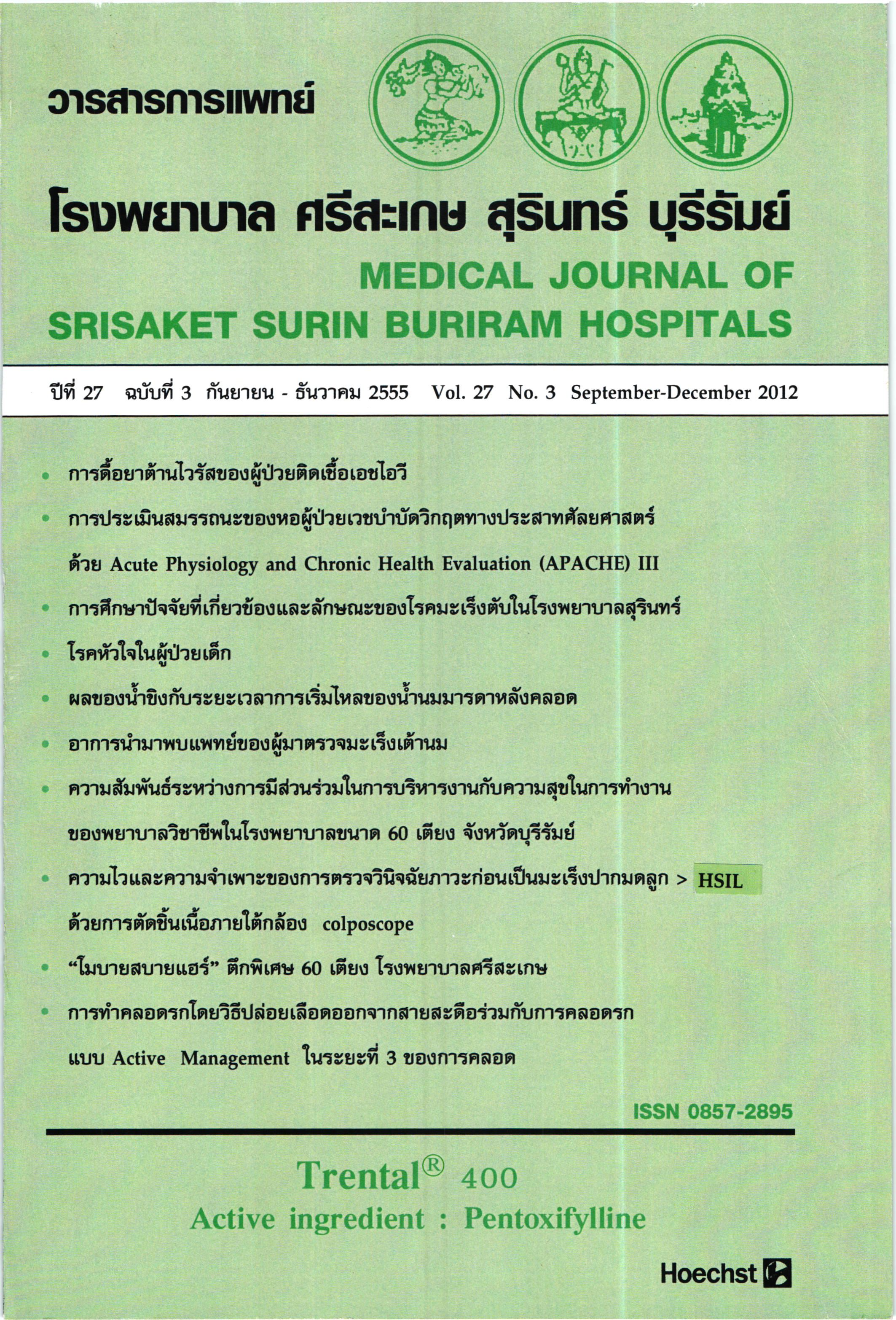Placental Cord Drainage after Vaginal Delivery as a Part of Active Management of Third of Labour
Main Article Content
Abstract
Background: Post partum hemorrhage is an important global health problem especially in developing countries according to high incidence of complications which resulted in morbidity and maternal mortality. Post partum hemorrhage caused by various factors includes prolonged labor, multiple gestation, fetal macrosomia, maternal anemia, preeclampsia and elective delivery. Substandard labor practice is the major cause that preventable and correctable.
Objective: To compare the difference of Total blood loss, incidence of Post partum hemorrhage, third stage of labor period and hematocrit level among active management method with placental cord drainage, active management with cord cramping and expectant management. Population and Labor patients underwent delivery at labor room of Surin hospital during February 1st 2012 to April 30th 2012.
Sampling: One hundred fifty patients were enrolled and assigned into three groups of 50 Patients were randomly assigned by simple random method into intervention and control group.
Methods: Patients were investigated for hematocrit level and received conventional labor care until delivery. Patients control group were assigned third period expectant management, the first intervention group was assigned third period care by active management with cord cramping and the second intervention group was assigned third period care by active management with placental cord drainage. Outcome measurement Total blood loss, incidence of Post partum hemorrhage, third stage labor period and hematocrit level. Patients were monitored until two hours after delivery then blood sampling for hematocrit level was done.
Statistical Analysis: Descriptive statistic was presented as frequency, percentile, mean and standard deviation. ANOVA was used to compare means of third labor period, total blood Loss and hematocrit level among three groups and Chi-square was used for test of difference between groups.
Results: Means of third labor period duration and blood loss were significantly different among three groups (p <0.5) but hematocrit level and incidence of bleeding were not significantly different (p <0.5).
Conclusions: Third labor period care by active management with placental cord drainage is convenient, easy managed and safe method to decrease post partum maternal complications.
Keyword: Post partum hemorrhage
Article Details
References
2. World Health Organization. Managing Complications in Pregnancy and Childbirth. Geneva: World Health Organization; 2000.
3. World Health Organization. Pregnancy, Childbirth, Postpartum and Newborn Care: A Guide for Essential Practice. 2nd ed. Geneva:World Health Organization; 2005.
4. Nagaya K, Fetters MD, Ishikawa M, Kubo T, Koyanagi T, Saito Y, et al. Causes of maternal mortality in Japan. JAMA 2000; 283:2661-7.
5. World Health Organization. The World Health Report 2005. France : Keith Wynn; 2005.
6. Prendiville WJ, Elbourne D, McDonald S. Active versus expectant manage¬ment in the third stage of labour (Cochrane Review). In: The Repro¬ductive Health Library. Oxford Update Software Ltd, Issue 3; 2000.
7. Prendiville WJ, ElbourneD, McDonaldS. Active versus expectant management in the third stage of labour (Cochrane Review). In: The Cochrane Library, Oxford: update softwareIssue 1; 2002.
8. Giacalone PL, Vignal J, Daures JP et al. A Randomized evaluation of two techniques of management of third stage of labour in women at low risk of postpartum hemorrhage. British Journal of Obstetric Gynecology 2000; 107: 396-400.
9. Gulani N, Chauhan MB, Rana M. Placental blood drainage in management of third stage of lobour. Journal of Obstetric Gynecology India 2001; 51: 46-8.
10. Dildy III GA. Postpartum hemorrhage: new management options. Clinical Obstetric Gynecoy 2002; 45: 330-44.
11. ACOG educational bullentin. Postpar turn hemorrhage. International Journal of Gynecology Obstetric 2004; 243: 79-86.
12. Soltani H, Dickinson F, Symonds I. Placenta cord drainage after spontaneous vaginal delivery as part of the third stage of labour. Cochrane Data base Systematic review 2005; 4: CD004665.
13. Sharma JB, Pundir P, Malhotra M, Arora R. Evaluation of placental drainage as a method of the placental delivery in vaginal delivery. Arch Gynecology Obstetric 2005; 271: 343-5.
14. Shravage JC, Silpa P. Randomized Controlled Trial of placental cord drainage for the prevention of post partum hemorrhage. The Journal of Obstetrics and Gynecology of India; 2008: 213-5.
15. PiphatJongkolsiri and Saknan Mano-taya. Placental cord drainage and the effect the duration of third stage labour, A Randomized controlled Trial. Journal Medical Association Thai; 2009, 92: 456-60.


